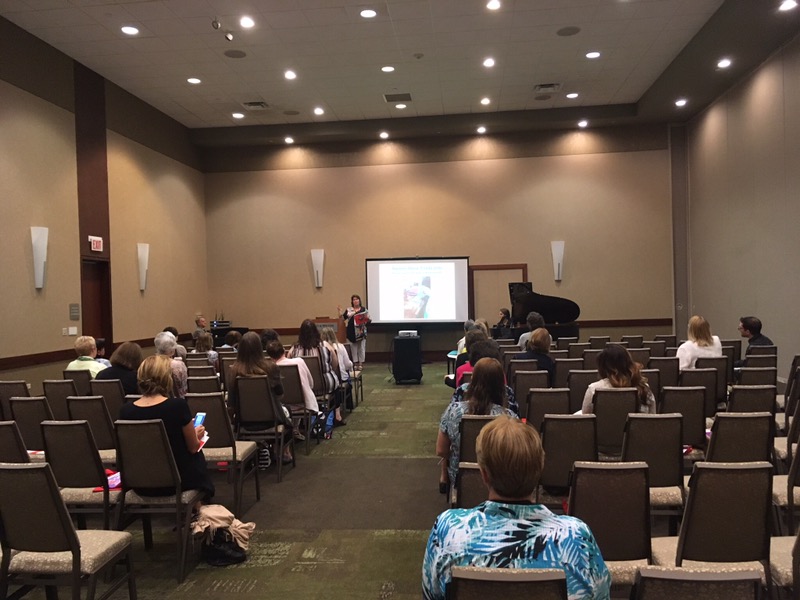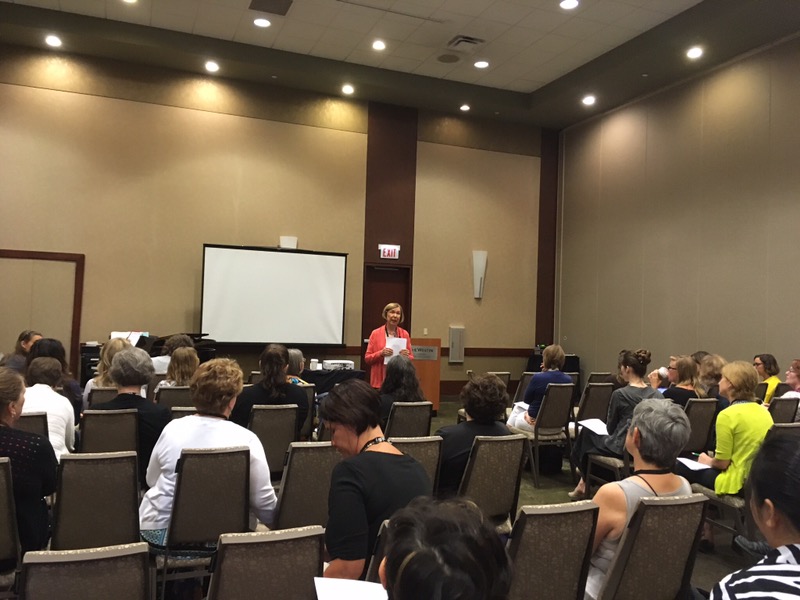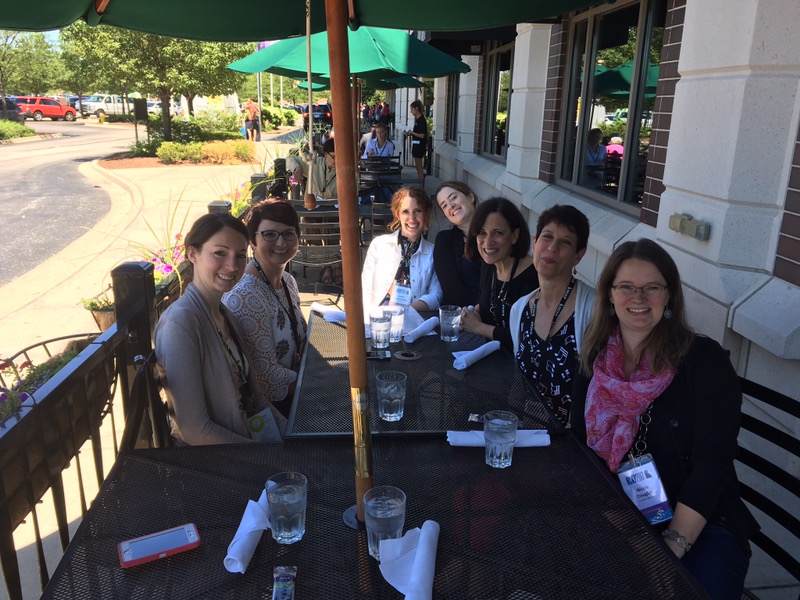[Click here to go back to Day 3.]
8am Kjos Publisher Showcase: Bastien New Traditions: Inspiring the Next Generation of Beginning Pianists, by Lori and Jane Bastien.
You probably know the Bastien name from the variety of method series (remember the iconic cover of the Bastien Piano Basics method?) and supplemental materials that were popular across past few decades. You may not know, however, that the Bastiens are back with the brand new method released last year (2016) called the Bastien New Traditions All In One Piano Course.
The Primer A book is off-staff reading, while the Primer B book is on-staff reading. If desired, the teacher can directly start the older beginner in the Primer B book. In this showcase, Lori demonstrated a number of the pieces from the method books, so that in hearing the pieces and the teacher duets we could gain a sense of the quality of the music.
 Here's a photo taken of me with Jane Bastien and her daughter Lori!
Here's a photo taken of me with Jane Bastien and her daughter Lori!

9:00am The Compelling Connection Between Improvisation and Reading from Birth, by Marilyn Lowe.
I was eager to attend this session, because Marilyn was one of the teacher trainers at the Music Learning Theory (MLT) training I attended in Boston last summer (2016) sponsored by the Gordon Institute for Music Learning (GIML). It was so fun to hear her session and get a refresher on many of the MLT concepts we learned!
Marilyn's session discussed how to build a foundation for music creation.
The first step is learning to listen. At about 18 months, language becomes dominant. Before that, the music experience is especially crucial. Sing short songs and chant rhythm patterns to your young ones at an early age.
We learn about life through making comparisons. We are largely a major tonality and duple meter society. The more variety in the experience, the richer the musical experience we can provide.
The main two ways we think about music are: rhythm versus tonal. We teach through a separation between those two aspects. And we learn one new thing at a time: Lowell Mason. Always establish context (for rhythm, it's meter; for tonal, it's tonality).
Marilyn suggested a variety of improvisation activities to use with students. For example: Have three students at the piano, all playing random keys: one playing macrobeats, one playing microbeats, one playing whatever rhythm patterns they desire to create a melody of some kind.
Gordon's rhythm syllable system has the advantage of not being tied to rhythm value names. The macrobeats are always du. The macrobeats are du-de for duple meter, or du-da-di for triple meter. Any further divisions are ta.
Big realization: You cannot hear rhythm values. You cannot hear time signatures. But you can hear meter.
Next, Marilyn explored the usefulness of the teaching question: "How can you change this?" Have the student explore. Once they learn a piece, have them change it. That's improvisation. Change register, dynamics, rhythm, etc.
Once rhythm and tonal patterns are learned, reading becomes much easier. And there are categories of rhythm patterns, depending on the type of content they contain.
Marilyn's session was a good primer on some important MLT principles!  A group of us enjoyed a lovely lunch on the patio at the hotel's restaurant.
A group of us enjoyed a lovely lunch on the patio at the hotel's restaurant.
 1:30pm Teaching Demonstration: Marvin Blickenstaff moderated by Robert Duke.
1:30pm Teaching Demonstration: Marvin Blickenstaff moderated by Robert Duke.
Marvin introduced his student Nina. They began with some warmup exercises and then went into a Schubert Impromptu.  Robert Duke's first observation was that Marvin intimately knew the music he was teaching. Teachers should always be able to play the music they are teaching at a high level of mastery, with great expressivity.
Robert Duke's first observation was that Marvin intimately knew the music he was teaching. Teachers should always be able to play the music they are teaching at a high level of mastery, with great expressivity.
Marvin demonstrates frequently during lesson time. And when he does, he explains verbally at the same time to get the message across. Marvin also sings frequently. The best pianists think vocally.
Marvin uses technical exercises as a way to build a vocabulary of gestures. Marvin doesn't believe in asking students to do things unless they know why. For example, why crescendo to the top note of a phrase? Don't stop at the "what", get to the "why".
Robert made observation of the infrequency of speech. Create experience through demonstration and informed imitation, and then you can talk about the "how". It's not often effective to talk about the how (especially over-explaining physical gestures) until after some experience is established. Additionally, physical gestures should not be addressed apart from discussing its auditory impact. 
This was an absolutely wonderful way to end the conference! I learned so much, and it is fun to start seeing more and more familiar faces at these events over time. And I made a number of new friends this year as well!
NCKP occurs every other year in the same location in Lombard, Illinois (outside of Chicago). If such a conference experience sounds fun to you, I'd encourage you to tuck away a little bit of money each month and plan towards attending in 2019. Maybe I'll see you there!



Joy, thank you so much for taking time to post this. Very informative and sometimes eye opening.
I’m glad to hear you enjoyed the NCKP summary, Milla! Conferences are always so helpful to me!
“Additionally, physical gestures should not be addressed apart from discussing its auditory impact.”
I remember having this revelation quite recently and it was really profound for me because I had really focused on the physical as an end point and not discussed it as a means to an end with sound production/tone etc. When I teach again I really want to put that idea into practise!
Yes, yes, and yes! This was an important awareness for me, too, as a teacher. I realized that I was lucky to have teachers during college who used this approach for me, and it is one that I definitely want to pass on to my students!